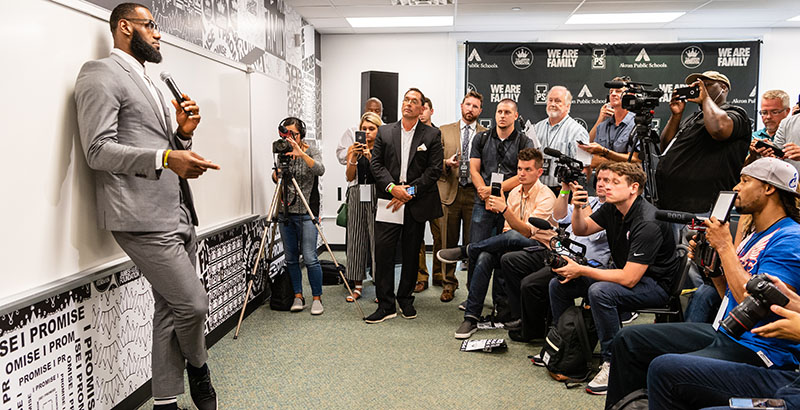Gill: Lebron James’s School Drew Lots of Attention, but It Doesn’t Take an NBA Star for Districts to Forge Innovative Partnerships

Last fall, NBA star LeBron James and his foundation received a lot of attention for opening the I Promise Academy in partnership with Akron Public Schools.
The school extends philanthropic work James had already been doing in his hometown. Many features of its model — a longer school year, wraparound services, family engagement and a focus on STEM and social-emotional learning — are designed to address challenges the basketball star experienced growing up. His mother moved around town a lot, and he didn’t always have a ride to school. He famously missed 83 days of fourth grade.
“Everything these kids are going through — the drugs, the violence, the guns, everything they’re going through as kids, I know,” James said when the school opened. “For me to be in the position where I have the resources, the finance, the people, the structure and the city around me — why not?”
Some commentators and media coverage have focused on James’s decision not to create a charter school but instead to invest in a school district.
But the arrangement, in which a nonprofit partners with a school district to improve outcomes for low-income students, is not unique. In fact, a growing number of communities are creating versions of these partnership schools, including Empower Schools in places like South Bend, Indiana, and Relay in San Antonio, Texas.
Both Indiana and Texas have laws that support this third-way approach, and Indianapolis has made Innovation Network Schools a central part of its school turnaround strategy. Like charter schools, partnership schools have a specific mission and identity. But they remain part of the district. In many cases, their teachers remain district employees, and unions might negotiate special rules to accommodate longer school days or years, as teacher representatives at I Promise have done.
In a 2017 brief from the Center on Reinventing Public Education, we concluded that these partnerships may offer many of the same benefits as high-performing charters, attract new resources to under-resourced areas and help instill a sense of community ownership. As with I Promise, school districts receive state funding for students in partnership schools, and their results count toward the district’s overall results in accountability systems. The students often remain district students for the purpose of state accountability and finance. Unlike I Promise, which, like many charter schools, admits students through a lottery, many partnership schools are neighborhood schools in the strictest sense and serve students within geographically defined attendance zones — or at least offer neighborhood enrollment preferences.
As it begins its second year, is I Promise living up to its name? As reported by the Akron Beacon Journal, all but one of last year’s third- and fourth-grade students re-enrolled this year. (The school is expanding to fifth grade this year and will eventually serve students in first through eighth grades.) The school is likely to receive an F rating based on state standardized tests, and the Journal describes some growing pains for staff. But there’s evidence that students are learning more than they were before. In reading, last year’s third-graders collectively moved from the first percentile in the country on the Measurement of Academic Progress (MAP) to the ninth. Fourth-graders moved from the first to the 16th. Still, the school has a long way to go for its students, who hope to obtain scholarships from James’s foundation, to reach college-level proficiency.
If partnership schools prove able to turn around persistently struggling schools, they may well be worth the effort. However, this is still a big if.
Promising, high-profile new schools in other traditional districts, such as in San Francisco, have found it difficult to achieve their vision and stay the course. When a superintendent leaves or a new school board takes office, will a partnership like I Promise survive? Would a change in school leadership challenge the school’s vision? Charter schools often struggle when startup or grant funding runs out; can partnership schools survive on public funding alone? And will they genuinely lead to instructional breakthroughs that neither district nor charter schools could achieve on their own?
These are important long-term questions that I hope education reporters and others will try to answer. For now, partnership schools offer an intriguing way for districts to join forces with other organizations to make more resources available to students and families, and to empower educators to create schools with coherent identities.
And we know it’s possible for districts to start them even if none of their native sons happens to become a 15-time All-Star.
Sean Gill is a research analyst at the Center on Reinventing Public Education at the University of Washington Bothell.
Get stories like these delivered straight to your inbox. Sign up for The 74 Newsletter

;)
